Possessive NounA possessive noun is a type of noun that refers to owning or possessing something-which means, it owns something. Like most circumstances, a possessive noun is produced by adding an apostrophe +s towards the noun; however, if the word is multiple but already concludes in s, simply an apostrophe is required. 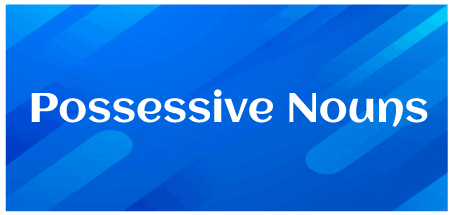
Boy's is a possessive word that modifies pencil in the following phrase: The boy's pencil smashed to pieces. The pencil clearly belongs to the youngster; the's denotes possession. The possessive case denotes ownership, control, and possession. A noun can be transformed from a regular person, location, or object to an individual, location, or thing that owns something by adding's (or occasionally just the apostrophe). There are a few distinct ways to form a noun's possessive. The dog's bone toy was misplaced. The dog possesses the bone toy, and we signify this by the usage of an apostrophe and "s" at the end of the dog. Is this Michael's novel? He pulled a feather from the bird's tail. The same pattern can be applied when a noun concludes in the letter s or s sounds. Therefore, this is a matter of style, as well as some style guidelines; advice leaving out the additional- "s". They have been welcomed to the boss's party for lunch. The coach tossed a fish into the cat's open mouth. 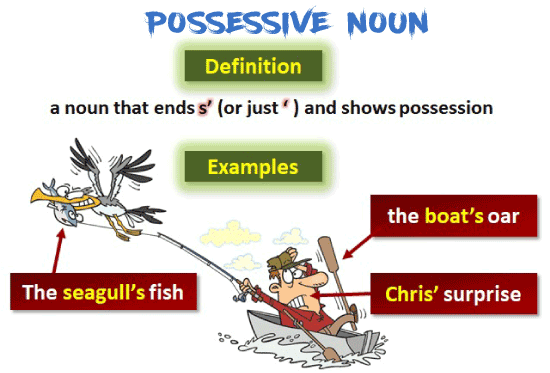
Plural nouns that conclude in an "s" consider adding an apostrophe to produce a possessive noun. Of course, several unusual plural nouns in English do not conclude with s. The hens' eggs were collected by the villagers early morning, at the time of sunrise. The children's toys were extraordinary and exquisite. Possession might be more abstract at instances. When discussing how long you've been doing it all, you could use an apostrophe. 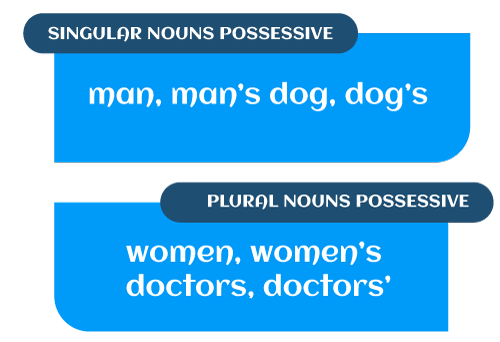
Five years' expertise in digital media has taught me what will perform well and what will not. Ten years' expertise is nothing to be overconfident about. But if you carefully understand, most times, it may sound more better to employ the term "of" instead of an apostrophe. Five years of expertise in digital media has taught me what will perform well and what will not. Ten years of expertise is nothing to be overconfident about. Rules Of Possessive NounPossessive nouns can be difficult for young learners, such as those learning English as a second language (ESL) since they behave like adjectives in the statement by transforming another word or pronoun. However, a few basic rules on how to use an apostrophe and the letter "s" correctly can help new students negotiate the difficulties of utilizing possessive nouns. 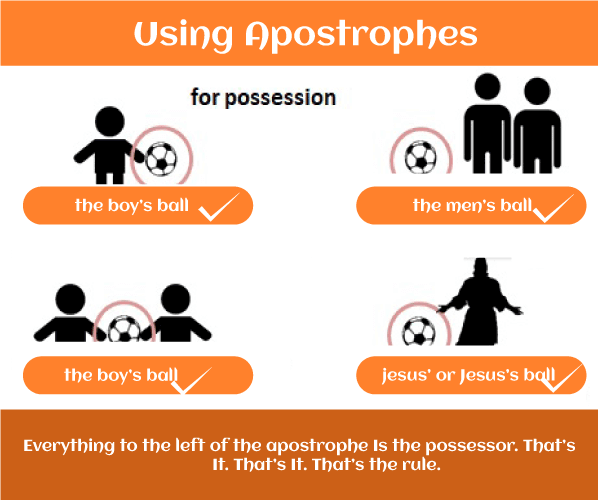
Possessive Nouns Come in Four TypesHere are some types of possessive nouns: Irregular possessive nouns: An unusual noun is one that has a different spelling in the plural type like as "woman" and "women." An irregular possessive noun is formed that uses the same English grammar as a standard plural noun, but with the addition of an apostrophe and the letter "s" at the conclusion of words. If an unusual plural noun ends in an "s," like "knives," simply an apostrophe is required. Possessive pronoun: This is a type of noun which, also called as an absolute or strong possessive pronoun, it is a pronoun that denotes ownership. This type of noun includes the words "mine," "theirs," "yours," and "hers." 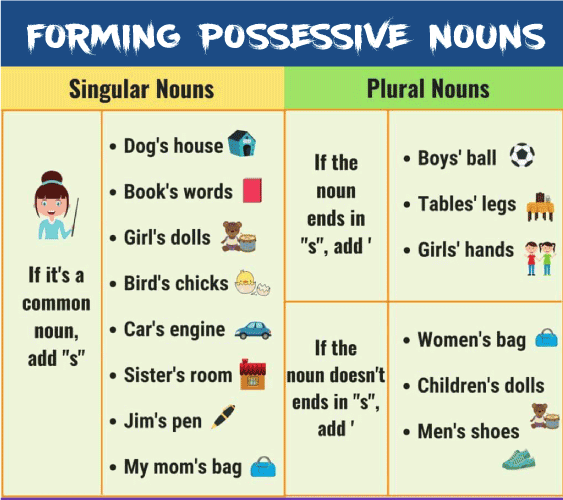
Furthermore, certain autonomous possessive pronouns, such as and, do not require the character "s" or an apostrophe like "my" and "her". Plural possessive nouns: This type of noun conveys possession or ownership by more than one individual, location, or object. With possessive apostrophes and the alphabet "s," it becomes a possessive noun, much like standard plural words. Plural possessive nouns ending in the character "s" only employ apostrophes-for instance, "loaves'" or "parents'". "Our," "your," and "their" are instances of plural possessive pronouns. Singular possessive nouns: This is a type of noun that corresponds to a single individual, location, or object that owns or is related to some other element in the phrase. An apostrophe and the letter "s" are required for respective possessive forms. As an instance of a singular possessive noun, consider the following: "Ricky's puppy is adorable." Possessive Noun ExamplesHere are numerous examples of possessive nouns: Irregular possessive noun: Possessive nouns with irregular spellings modify their spelling to demonstrate possession." men's rights," "octopus's tentacles," and "swords' blades" are instances of sentences that employ an irregular possessive noun. Possessive pronouns: There are seven possessive pronouns that are definite or sturdy: "mine," "ours," "yours," "its," "his," "hers," and "their." "My," "our," and "your" are all of this type that is also weak possessive pronoun. Plural possessive nouns: To signify ownership, plural possessive nouns include an apostrophe and the suffix "s" to a term. "The Smits' home" and "horses' shoes" are two examples of plural possessive nouns. Singular possessive nouns show ownership of a single individual, location, or item. Here are a few examples: tutor's class plans; teacher's prepared worksheets. Possessive Nouns: How to Use ThemThere are numerous guidelines for using possessive nouns correctly: Compound possessive: A compound term is formed by combining two or more sets of words, whereas a compound possessive is formed by combining two or more terms to signify possession. If the compound word doesn't really belong to a singular body, such as Bella and Jackie each having a new automobile, then insert apostrophes and the word "s" to both nouns. If the compound term creates a new single group instance, "Bella and Jackie's new bike,"-the apostrophe and word "s" must be added to the second noun. S sound: Whenever a possessive noun ends in the suffix "s," there seem to be two major schools of thought as to how to start the pronunciation of the noun. Certain grammar experts believe that the "s" sound should never be used; for instance, speakers should say "jeep's horn" and "jeeps' horns" in the very same way. Some argue that adding phonetic endings is acceptable; for instance, the speaker should accent "Jim's pencil" as "Jimz-es pencil." All schools of thought are valid. Inanimate objects: There seem to be two schools of thought about whether inanimate items can indeed be possessive nouns, as in "The chair's leg was unsteady." Others argue that this is only improper if an accepted idiom already exists. Others argue that it is only inappropriate if there is an existing acceptable phrase (for example, "the children's head" rather than "the head of the child"). It is both legal and wrong to construct the possessive for inanimate objects based on the source. Time: When referring to possession, it is possible to state "5 years' experience." However, saying "5 years of experience" would sound less odd. Both are, once again, appropriate. 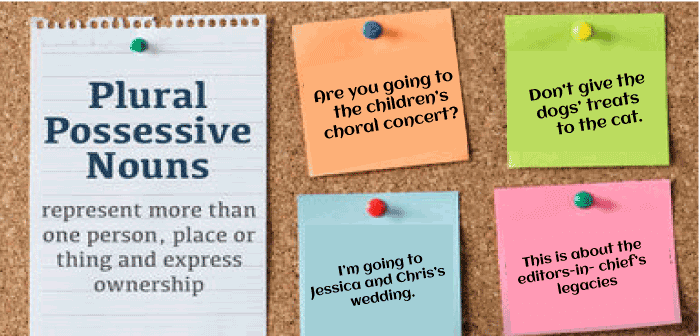
Rule of Possessive NounRule 1: Singular Possessive is the first rule. Add an apostrophe and an S. Several singular nouns can be made possessive by attaching an apostrophe + "s" to the ending. The kitten's collar is orange. Joe's vehicle is awful. We took a good look at the team's logo. This guideline will be the most important to you, so remember it. There are, nevertheless, often exceptions that prove the rule. If a singular noun concludes with "s," you could either put an apostrophe along with "s" or just an apostrophe to the ending. Both are accepted as right. Which one you use is determined by how uncomfortable the term sounds with an additional "s" at the ending. Mr. Robbins' residence or Mr. Robbins's residence (both correct) Rule 2: Plural Possessive is the second rule. After the letter S, place an apostrophe. To make possessive, put an apostrophe to the ending of a plural nouns that already conclude in "s." Plural nouns that already conclude in "s" do not need an extra "s." Just place the apostrophe at the ending of the plural noun to signify that it has become a plural possessive noun. Here are a few examples of this in case. The businesses' laborers began the protest together. Visitors ought to tidy out the horses' kiosks. The two nations' armies accumulated on the frontier. Of fact, there are other words in English that really are plural but do not contain an "s" at the ending, such as "children," "lamb," and "men." When creating sentences, these irregular plural phrases are processed as if they were singular ones like Children's, Lamb's, or Men's. Rule 3: It Does Not utilize an Apostrophe The possessive type of the pronoun "it" is the exception to the apostrophe + "s" rule. It is not essential to utilise an apostrophe to create "its" possessive. Take a glance at some examples of how this works. They were unsure about its phases. They tracked its footprints. Its origins were unknown to the researcher. Since "it's" is a shortening of "it is," it does not claim the ownership with "it's." As a result, you should not use an apostrophe when indicating ownership. 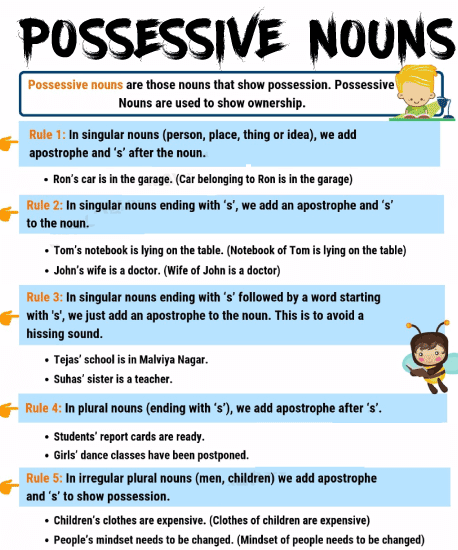
Rule 4: Compound Nouns and Hyphenated Nouns Hyphenated and complex phrases can be difficult to spell. Examine how you construct these possessives using a few instances. To the conclusion of compound words or the last term in hyphenated nouns, use the apostrophe + "s." My sister-in-law's dish for pancakes is my family's favorite. The Indian Postal Service's stamps are accessible across all the places and centers. They stood before two attorney general's personnel and knew that they were in a problem now. Rule 5: When More Than One Noun Shares Possession You could be writing about two persons, locations, or items who share ownership of an item. Make very sure to just use the apostrophe + "s" with the last noun. If two or more nouns share possession, express it just one time on the last noun in the grouping. The nursery rhyme mainly features Jack and Jill's water bucket. Abbot and Costello's comic routine "Who's on First?" is a masterpiece. Eric, Johnny, and Kyle's explorations are ridiculously funny. Rule 6: Distinguish Possession of Several Nouns Whenever two or more nouns show possession, but the ownership is distinct, every noun receives the apostrophe + "s" to signify distinct possession. The instances may assist you in understanding what this implies. This is the most challenging rule of entire list, yet you won't need to resort to it so often. Ricky and Tommy's changing rooms featured pink and purple, respectively. (Each person got their personal changing room, which is a spare room.) President Barack Obama and Senator Clinton both have excellent educations. (Everybody owns their degree, yet they received it separately.) Tim's and Chloe's bicycles are on the stand. (Both of the person have a bicycle on the stand.) Note: This concludes the entire guidelines and detailed overview on Possessive Noun. Practicing it regularly can help you get a better grasp of this type of noun.
Next TopicVerb
|
 For Videos Join Our Youtube Channel: Join Now
For Videos Join Our Youtube Channel: Join Now
Feedback
- Send your Feedback to [email protected]
Help Others, Please Share










